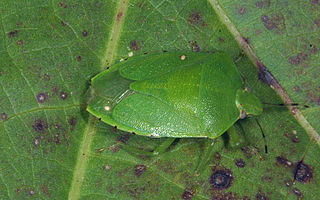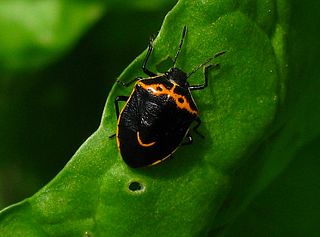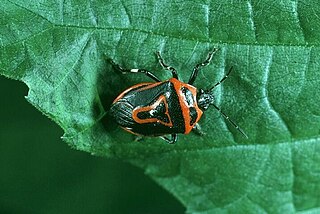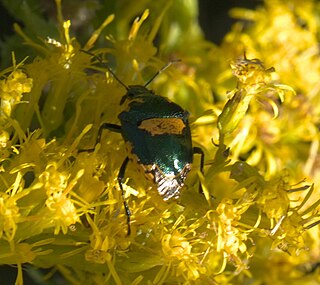
The Pentatomoidea are a superfamily of insects in the Heteroptera suborder of the Hemiptera order. As Hemiptera, they share a common arrangement of sucking mouthparts. The roughly 7000 species under Pentatomoidea are divided into 21 families. Among these are the stink bugs and shield bugs, jewel bugs, giant shield bugs, and burrower bugs.

Pentatomidae is a family of insects belonging to the order Hemiptera, generally called shield bugs or stink bugs. Pentatomidae is the largest family in the superfamily Pentatomoidea, and contains around 900 genera and over 4700 species. As hemipterans, the pentatomids have piercing sucking mouthparts, and most are phytophagous, including several species which are severe pests on agricultural crops. However, some species, particularly in the subfamily Asopinae, are predatory and may be considered beneficial.

The western conifer seed bug, sometimes abbreviated as WCSB, is a species of true bug (Hemiptera) in the family Coreidae. It is native to North America west of the Rocky Mountains but has in recent times expanded its range to eastern North America, to include Ontario, New Brunswick, Nova Scotia, Michigan, Maine, Pennsylvania, New York, Connecticut, Massachusetts, and New Hampshire, and has become an accidental introduced species in parts of Europe and Argentina.

Scutelleridae is a family of true bugs. They are commonly known as jewel bugs or metallic shield bugs due to their often brilliant coloration. They are also known as shield-backed bugs due to the enlargement of the thoracic scutellum into a continuous shield over the abdomen and wings. This latter characteristic distinguishes them from most other families within Heteroptera, and may lead to misidentification as a beetle rather than a bug. These insects feed on plant juices from a variety of different species, including some commercial crops. Closely related to stink bugs, they may also produce an offensive odour when disturbed. There are around 450 species worldwide.

Acanthosomatidae is a family of Hemiptera, commonly named "shield bugs" or "stink bugs". Kumar in his 1974 world revision recognized 47 genera; now this number is 55 genera, with about 200 species, and it is one of the least diverse families within Pentatomoidea. The Acanthosomatidae species are found throughout the world, being most abundant in high-latitude temperate regions and in subtropical regions at high altitudes.

The green stink bug or green soldier bug is a stink bug of the family Pentatomidae.

Cosmopepla conspicillaris is a species of insect in the family Pentatomidae first described by William Dallas in 1851. Due to its common preference for plants in the genus Stachys, it is often called the hedgenettle stink bug. It is also known as the conspicuous stink bug, two-spotted stink bug or happy bespectacled stink bug depending on locality. The name two-spotted stink bug is better applied to another species, Perillus bioculatus.

The brown marmorated stink bug is an insect in the family Pentatomidae, native to China, Japan, Korea and other Asian regions. In September 1998 it was collected in Allentown, Pennsylvania, where it is believed to have been accidentally introduced. The nymphs and adults of the brown marmorated stink bug feed on over 100 species of plants, including many agricultural crops, and by 2010–11 had become a season-long pest in orchards in the Eastern United States. In 2010, in the Mid-Atlantic United States, $37 million in apple crops were lost, and some stone fruit growers lost more than 90% of their crops. Since the 2010s, the bug has spread to the nation of Georgia and Turkey and caused extensive damage to hazelnut production. It is now established in many parts of North America, and has recently become established in Europe and South America.

Bagrada hilaris is a species of shield bug known by the common names bagrada bug and painted bug. It could be mistaken for or erroneously referred to as harlequin bug. It is native to southeastern Africa. It is known elsewhere as an introduced species, including California and Arizona, where it was first reported in 2008. It is a major pest insect of Brassica oleracea crops, and related crucifers such as turnips, rape, and mustard. The adult and nymph of the species suck sap from the leaves of the plants, causing wilting, yellowing, and stunting of growth. Besides crucifers, the bugs are known on papaya, sorghum, maize, potato, cotton, caper, pearl millet, and some legumes. Large numbers of the bug congregate on the plants and cause extensive damage.

Tessaratomidae is a family of true bugs. It contains about 240 species of large bugs divided into 3 subfamilies and 56 genera.

Cosmopepla is a genus of stink bugs in the family Pentatomidae. Cosmopepla lintneriana is the type species. Cosmopepla lintneriana was first described in 1798 by Johan Christian Fabricius as Cimex carnifex.

Perillus bioculatus, the two-spotted stink bug or double-eyed soldier bug, is a species of insect in the family Pentatomidae. They are native to North America but have been introduced to Eastern Europe and North India. Both the larval and adult stages are specialized predators of eggs and larvae of the Colorado potato beetle. However, the first instar larvae feed by sucking the juices out of potato stems.

Telenomus podisi is a species of egg parasitoid wasps described by William Harris Ashmead in 1893 and placed in the family of Platygastridae. It is a parasitoid of the brown stink bug, Euschistus heros and can be raised in labs on the eggs of Cosmopepla lintneriana, Podisus maculiventris, and Euschistus servus. This wasp can be used in integrated pest management to control E. heros. The insecticide Imidacloprid is lethal for these wasps, and other insecticides have been shown to negatively impact rates of egg parasitism.

Mormidea lugens is a species of stink bug in the family Pentatomidae found in the Caribbean, Central America, and Eastern North America. In Illinois, adults have been observed emerging from overwintering sites in late April, and continue to be observed until early November, and appear to be bivoltine in this area. Eggs are approximately 0.7 millimetres (0.028 in) in diameter, pale yellow, and laid in small clusters of 6 to 11 eggs. Adults are bronze in color, with a white-yellow border around the scutellum, and are 5.0–7.2 millimetres (0.20–0.28 in) in length. In laboratory conditions, at approximately 24 °C (75 °F), development from eggs to adults has been documented to take between 39 and 50 days, and appears to be affected by the species of host plant. Mormidea lugens has been documented to feed on timothy, sedges, as well as deer-tongue grass, and Bosc's panic-grass. It has been collected from pale sedge and wide-leaved spiderwort but has not observed feeding on these species, and deer-tongue grass appears to be an insufficient food source for development.

Thyanta is a genus of stink bugs in the family Pentatomidae. There are about 19 described species in Thyanta.

Piezodorus guildinii, known generally as red-banded stink bug, is a species of stink bug in the family Pentatomidae. Other common names include the small green stink bug and alfalfa bug.
Moromorpha is a genus of stink bugs in the family Pentatomidae. There is one described species in Moromorpha, M. tetra.

Stiretrus anchorago, commonly known as the anchor stink bug, is a species of predatory stink bug in the family Pentatomidae. It is found in Central America and North America. It is known to prey upon Epilachna varivestis and Hypera postica.

Proxys punctulatus, the black stink bug, is a species of stink bug in the family Pentatomidae. It is found in the Caribbean Sea, Central America, and North America.

Cuspicona simplex, commonly known as the green potato bug, is a herbivorous species of stink bug native to Australia and introduced to New Zealand. It feeds on nightshades. It is primarily known as a pest of potatoes, tomatoes, and other crops in the nightshade family.



















